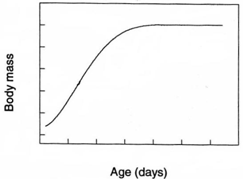Chapter 6 - Introduction
Chapter 6 - Introduction
There are several measures that can be used to evaluate the performance of a flock of broilers – growth rate, days to market, mortality, and feed efficiency. Feed is typically the most costly expense in broiler production. As a result, feed efficiency is typically the primary tool by which a flock is evaluated. In North America, feed efficiency is calculated by dividing feed intake by weight gain, resulting in typical values around 1.8 for 42 day old broilers. Thus the lower the number (referred to as Feed Conversion Ratio – FCR) the more efficient the flock was in using the feed supplied. In some European countries, however, feed efficiency is calculated as weight gain divided by feed intake, and a corresponding value would be 0.56. For Europe, therefore, higher numbers represent a more efficient feed conversion.
TYPICAL GROWTH CURVES FOR BROILERS

Figure 6.1 - Generic growth curve for broilers
As is typical of all animals, broilers experience a period a rapid growth early in their development (see Figure 6.1). This is then followed by a slow rate of growth as more feed is used in maintaining the already existing body structure. As a result, feed efficiency is much better in the first weeks of broiler production and then declines with increased target market weight.
Today broiler companies have moved from standardized growing programs to one tailored to meet specific local goals and economic conditions. Many factors affect both growth rate and feed intake, and thus affect feed efficiency. The single largest factor affecting feed efficiency is the energy level of the feed. Several years ago high energy feeds were given - examples 3,000 kcal/kg (1,361 kcal/lb) in the starter; up to 3,200-3,300 kcal/kg (1,452-1,497 kcal/lb) in the finisher. Now, because of the cost of energy-rich feedstuffs, as well as other management problems, much lower energy values are typically used in formulating all diets of a feeding program. Broilers are also being grown to a wide variety different market weights. Feed efficiency declines as broilers get older so can not be compared with different age flocks.
